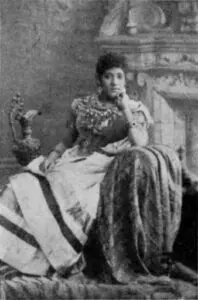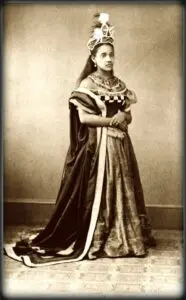Learn about Madame Selika
Marie Smith, eventually known as Madame Selika, moved with her family from Natchez, Mississippi, to Cincinnati, Ohio, soon after birth. Her beautiful voice was discovered in childhood, and a wealthy family funded her music education. As a young adult, she moved to San Francisco to study music with Signora G. Bianchi and debuted as a concert soprano.
In the 1870s, Smith moved to Chicago, where Antonio Farini developed her coloratura soprano voice and taught her the Italian singing method. She also met a fellow student, Sampson Williams, an operatic baritone she would later marry.

In 1878, Williams became the first Black artist to perform at the White House, being introduced by Frederick Douglass and singing for President Rutherford B. Hayes and First Lady Lucy Webb Hayes. Her rendition of E. W. Mulder’s “Polka Staccato” earned her the nickname the “Queen of Staccato.”
Williams continued to perform in the United States and adopted the stage name “Madame Selika,” believed to be from the character Sélika in Giacomo Meyerbeer’s opera L’Africaine.
Related Article: The History of African Americans in Cincinnati

From 1882 to 1885, Madame Selika toured Europe with her husband, who took the stage name “Signor Velosko (the Hawaiian tenor)” and even performed for Queen Victoria. The Williams then toured around the world before settling in Cleveland.
Despite her reputation and talent, Madame Selika had difficulty obtaining quality management and was known to organize her tours and concerts. Between 1885 and 1891, the couple opened a music studio in Cleveland and toured the United States, performing primarily for all-Black audiences.
Related Article: Loretta C. Manggrum, the first African American to receive a degree from CCM
In 1896, Madame Selika joined fellow Black singers Flora Batson and Sissieretta Jones for a historic performance at Carnegie Hall. Williams gave private lessons after her husband died in 1911 and taught at the Martin-Smith Music School in New York City.
Her legacy remains as the most recognized and lauded African American woman singer of the late 19th century. The American operatic stage did not welcome Blacks until the 1930s.
Sources
19th Century Black Cincinnatians you should know | Cincinnati & Hamilton County Public Library (cincinnatilibrary.org)
Marie Selika Williams – Wikipedia
Marie Selika Williams Gave White House Recital – Racing Nellie Bly-Famous, women in history
First African American to perform at the White House – Media Diversified
Vocalist Marie Selika Williams born – African American Registry (aaregistry.org)
About The First 28
The First 28, graciously sponsored by the Greater Cincinnati Foundation, celebrates Black Cincinnatians who were the first in their fields. Each day during Black History Month, we will celebrate athletes, artists, business leaders, civil rights activists, educators, physicians, and politicians.
The Voice of Black Cincinnati is a media company designed to educate, recognize, and create opportunities for African Americans. Want to find local news, events, job postings, scholarships, and a database of local Black-owned businesses? Visit our homepage, explore other articles, subscribe to our newsletter, like our Facebook page, join our Facebook group, and text VOBC to 513-270-3880.
Images provided by the Wikipedia and Racing Nellie Bly
Comments are closed.